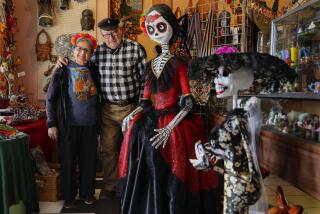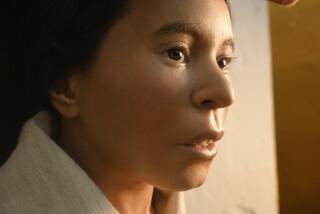1,500-Year-Old Mummy Found in Peru Pyramid
- Share via
Archeologists in Peru have discovered a 15-century-old mummy of a tattooed Moche woman entombed with a dazzling collection of weapons and jewelry.
The woman, clearly a member of royalty, was buried with a sacrificed teenage slave at her feet and surrounded by multiple signs of femininity, including precious jewelry, golden needles and bejeweled spindles and spindle whorls for spinning cotton.
But her burial bundle also contained gilded copper-clad war clubs and finely crafted spear throwers -- objects never before seen in a Moche woman’s tomb.
“Why would a woman be accompanied by weapons?” said archeologist John Verano of Tulane University, who reported the find in the June issue of National Geographic magazine. “It’s somewhat of a mystery who she is.”
Given the quantity and unusual preservation of the artifacts, he said, “it is going to take archeologists years of work to try to unravel the mystery.”
UCLA archeologist Christopher B. Donnan, who has been working for years in the nearby Jequetepeque Valley, said many of the burial goods were identical to royal artifacts he had discovered there.
“There are implications of contact between royalty in two different valleys,” he said. “We’ve never been able to recognize something like that before.”
The find suggests that the Moche, like other South American cultures, cemented alliances between cities through intermarriage.
The mummy was discovered by Verano and Peruvian archeologists from the National Institute of Culture at a site called El Brujo, or the Wizard, on the Peruvian coast about an hour’s drive north of Trujillo and more than 300 miles north of the capital, Lima. The site was occupied by a variety of groups from about 2500 BC through the Spanish colonial period, when it was abandoned.
The Moche flourished there from about AD 100 to 700. They were primarily farmers who diverted rivers into a network of irrigation canals.
A sophisticated culture, the Moche raised huge pyramids of sun-dried adobe bricks, laying their noblest dead inside. Although they had no written language, their artifacts document their lives with detailed scenes of hunting, fishing, combat, punishment, sexual encounters and elaborate ceremonies.
The mummy was discovered in a pyramid called Huaca Cao Viejo, a massive structure 100 feet tall. It was built in several phases, with successive generations enlarging it.
The mummy, which dates to about AD 450, was placed on a covered patio that was subsequently buried under about 15 feet of adobe bricks, which protected it from both the weather and looters.
The mummy bundle itself “was huge, obviously symbolic of her status,” Verano said. But to remove it, the team first had to take out a skeleton lying alongside it.
“It was a well-preserved sacrifice, with a rope around its neck -- the girl had been strangled,” he said. Some servants were sacrificed at funerals, while others volunteered to accompany their masters into the afterlife.
It took eight men to lift the bundle from the grave and carry it to a nearby lab for inspection. The team then carefully removed the hundreds of yards of cotton cloth that encased the mummy, revealing the body of a woman who was about 5 feet tall -- average for the time -- and in her mid- to late 20s.
She was apparently in good health with no signs of nutritional deficiencies, although she had one tooth that would have become abscessed if she had lived longer. Her abdominal skin was wrinkled and collapsed, and bone scarring indicated that the woman had given birth at least once.
With no obvious cause of death, Verano speculated that it was “most likely some sudden infectious disease, like pneumonia or bronchitis, that wouldn’t leave a mark on the skeleton.”
The woman was heavily tattooed on her forearms, upper arms, the backs of her hands and on her ankles and feet. Some tattoos were of mythical animals that were also depicted on murals at the site. There are also geometric and other designs that “so far, are hard to figure out,” he said.
Archeologists cannot effectively compare the tattoos to those on other corpses, Verano said, because most burials previously discovered are simply skeletons with little or no skin remaining. The few tattoos that have been observed on skin fragments from Moche women have different designs, he said.
The woman was adorned with multiple necklaces, some of gold and others of turquoise and quartz. She had multiple nose ornaments, earrings in the form of gold crosses and four tiaras or crowns, each with a different design of a fanged face.
Two tall, cylindrical headdresses and several ceramics in the tomb were clearly from Jequetepeque, Donnan said. For the headdresses, in particular, “We know of no other place where they were made and used,” he said.
Because the headdresses were generally worn only by men, Donnan said, their presence suggests that a prince from Jequetepeque may have come to El Brujo to woo or wed the woman or, at the very least, to honor her after her death.
More to Read
Sign up for Essential California
The most important California stories and recommendations in your inbox every morning.
You may occasionally receive promotional content from the Los Angeles Times.









